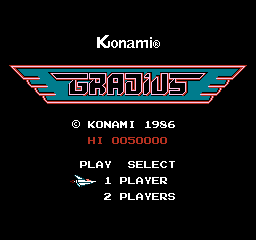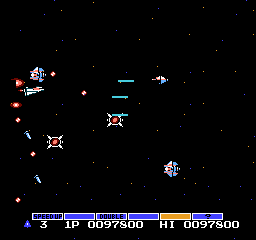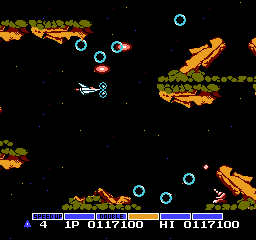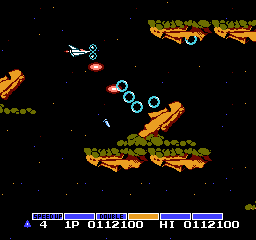Publisher: Konami
Year: 1986
Genre: Side-Scroll Shmup
The 80’s were an exciting time in the world of space exploration. America (and all those other countries that don’t matter) spent absurd amounts of money on space programs. Why? Because space was the next frontier of warfare, of course! Basically, every superpower (all two of them) and all those other countries that don’t matter wanted to put more blinky metal things up in the sky faster than anyone else so that they could perfect the art of putting blinky metal things in the sky. If any of their little blinky things had been the glorious Warp Rattler from Gradius, the Cold War would have been cut mercifully short.

Gradius, as stated, is about a spaceship called the Warp Rattler. The Rattler is, if I understand the plot correctly, on a mission to protect the planet Gradius from evil amoebic aliens from a sub-space star cluster called Bacterion. This is really, of course, just an excuse for some awesome schmup action – nothing in the game reflects this plot in any manner sufficient to warrant its inclusion.

I’ll take a moment here to point out that the name of the game, “Gradius,” is a particularly serendipitous example of Engrish – the game’s intended name was “Gladius,” but, due to the lack of distinction between r and l in Japanese phonetics, coupled with the Romaization standards of the day, resulted in “グラディウス” (Gu-Ra-Te-I-U-Su) being rendered as “Gradius.” Now, this is the part where every weeaboo reading this begins furiously slapping their greasy cheeto-stained sausage fingers against their keyboard in a race to discredit me by pointing to the Wikipedia edit that insists that the name is not an accident [citation needed]. Fact is, there are numerous reasons to believe that the name is an error. First and foremost, “Gradius” doesn’t mean anything. Second, it’s written in katakana, which is reserved primarily for loanwords from foreign languages. Third, where other planets and such are named in the game series, there is a distinctly Greco-Roman motif. Fourth, and finally, it really pisses the weeaboo population off when you point out that the game’s title is a failed attempt at gratuitous Engrish.

But I digress – let’s talk about the game – and what a game it is! Gradius, despite being a fairly early entry into Nintendo’s lineup, remained the best shmup available for the system through the system’s entire support run. The enemies, while not individually memorable for the most part, are well-designed and cleverer than you expect – anticipating your moves at times and leading you with their shots, while making predictable enough mistakes that the game doesn’t feel like it’s cheating. Even if the enemies may feel generic or overly simple, the level design is memorable enough to make up for it, featuring both interesting eye-catching design and the right combination of malevolent architecture. From a player perspective, the powerups are all useful (even if some seem more useful that others) and the powerup chain is long and varied enough to give you opportunities for a bit of strategy.
The fact that Gradius comes after Ghosts ‘n Goblins in the review lineup makes me almost* wish I had given Ghosts ‘n Goblins more attention. The games, are, in a sense, very much the same despite being very different. Both are flagship franchises of their respective companies. Both games are undeniably Nintendo hard. Both games were re-released on the SNES as “sequels” with some improvements, but very few salient changes. Despite their being so similar, however, the games could not be more different in other respects: where Ghosts ‘n Goblins is borderline unplayable in its zealous efforts to kick your ass (and make you start all over), Gradius is just frustrating enough to keep you coming back (bonus: the final boss is super-easy as a reward for killing his guardians). Where Gradius and its spinoffs have more or less stuck to the same winning formula, Ghosts ‘n Goblins has diverted into zany, unusual spin-offs such as the Action RPG Gargoyle’s Quest and even some bizarre puzzle game that never got ported. Finally, while the SNES “versions” of both Ghosts ‘n Goblins and Gradius added brand new powers, enemies and options** to the (mostly) unchanged games, the SNES version of Ghosts ‘n Goblins scales back the difficulty significantly (ending with results that are still Nintendo Hard by any standard) while the SNES version of Gradius is actually noticeably more difficult than the Nintendo version.
**pun not intended
John’s Rating: 5.0 out of 5.0. I know that I flat-out admitted that the Super Nintendo version of the game was better, but let’s face it: this is the best Shmup available for the NES, bar none, and possibly one of the most influential Shmups of all time. Frankly, if this game doesn’t deserve a 5.0, no shooter for the NES does, and I am simply unwilling to accept that possibility.
